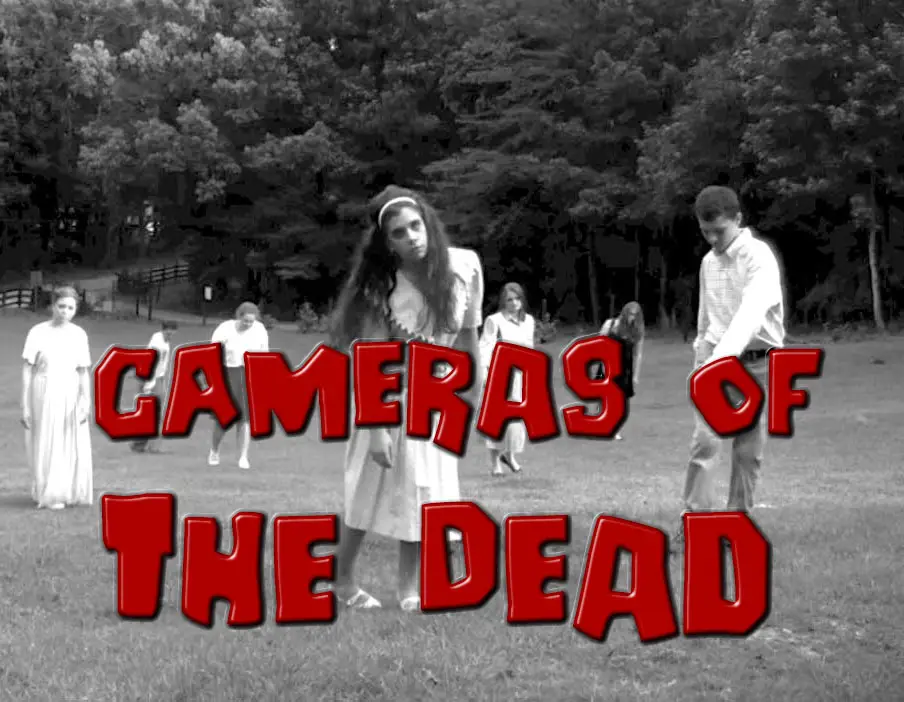 This review is part of the Cameras of the Dead series which I have been publishing every year on Halloween and “Halfway to” Halloween, featuring three cameras that I’ve wanted to review that either didn’t work, or was otherwise unable to shoot.
This review is part of the Cameras of the Dead series which I have been publishing every year on Halloween and “Halfway to” Halloween, featuring three cameras that I’ve wanted to review that either didn’t work, or was otherwise unable to shoot.
I am republishing each of those individual reviews this October in anticipation of this Halloween’s Cameras of the Dead post as a way to revisit the cameras of the past that allows them to be properly indexed on the site.
This is a Canon T90, a professional quality 35mm SLR camera made by Canon Inc. between the years 1986 to 1998. At the time of it’s release, it was Canon’s top of the line SLR in their T-series and the most advanced manual focus FD-mount Canon camera ever made. It was a well featured camera loaded with state of the art technology and was very popular with professional photographers. Built to a very high level of quality, it was nicknamed as “the tank” by Japanese photojournalists because of it’s heft and durability. Although an extremely well made camera, it had one technological flaw which didn’t show up until about 20 or so years after it was made, which causes the shutter to fail in nearly all examples of the camera, producing an EEE error message in the LCD.
Film Type: 135 (35mm)
Lens: 50mm f/1.4 Canon Lens coated 6-elements
Lens Mount: Canon FL/FD Breech Lock Bayonet
Focus: Variable
Viewfinder: Fixed Pentaprism Reflex with interchangeable viewing screens, and dual LED/LCD readout
Shutter: Vertically Traveling Electronic Shutter
Speeds: B, 30 – 1/4000 seconds, Stepless, Manually selectable in 1/2 stops
Exposure Meter: Silicon Photo Cell w/ 3 metering patterns
Battery: (4) AA Alkaline/NiCD/NiMH 1.5v batteries
Flash: Hot shoe with 1/250 Flash Sync
Weight: 1190 grams (w/ lens), 887 grams (body only)
Manual: http://www.cameramanuals.org/canon_pdf/canon_t90.pdf
Sales Brochure: https://www.pacificrimcamera.com/rl/00285/00285.pdf
My Thoughts
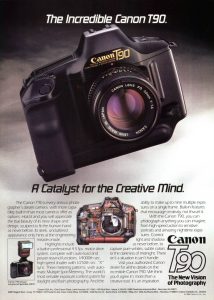
In the vintage camera world, there are cameras that have a reputation for extreme reliability. Models that assuming they were not horribly abused throughout their lives almost always still work. Kodak Brownies, Argus C3s, Nikon Fs, and Minolta SRTs are a couple such examples.
On the other end of the spectrum, there are those that almost always have problems. Whether it’s due to shoddy craftsmanship, an overly complicated design, or the planned obsolescence of electronics, these examples are almost never found in good working order.
This is about a camera from that latter group, the Canon T90.
The biggest shame about this, is that when in working condition, the Canon T90 is an absolute beast of a camera. It was a state of the art professional model that with the exception of auto focus, could do everything a photographer in the 1980s could ever imagine.
Advertised as a “dream camera”, the T90 featured 3 different electronic motors, one of which offered 4.5 fps continuous shooting, a top 1/4000 second shutter speed, a high-speed 1/250 second flash synchronization, three metering modes with multi-point spot metering, an advanced viewfinder with 7-segment LED display, and a bevy of other options. The camera was big, it was heavy, and it was expensive. Selling for $599 body only, which when adjusted for inflation is about $1400 today, the Canon T90 was the most expensive manual focus camera Canon ever offered until that point.
But therein lied it’s biggest flaw. Canon wanted to include so much technology in the camera as they possibly could, but unfortunately, they did it at a time when compact electronics were still quite primitive. Canon used a lot of cutting edge stuff in the T90 that has not aged well.

 Like any electronic camera, the camera is sensitive to shock, moisture, and extreme temperatures. But beyond that, it had one problem that nearly every example seems to suffer from today, which is the dreaded “EEE” message on the camera’s top LCD. While this message could mean one of a variety of faults with the camera, it usually has to do with some kind of solenoid beneath the reflex mirror that controls some part of the shutter (if I’m sounding exceptionally vague here, it’s because I still don’t completely understand the problem).
Like any electronic camera, the camera is sensitive to shock, moisture, and extreme temperatures. But beyond that, it had one problem that nearly every example seems to suffer from today, which is the dreaded “EEE” message on the camera’s top LCD. While this message could mean one of a variety of faults with the camera, it usually has to do with some kind of solenoid beneath the reflex mirror that controls some part of the shutter (if I’m sounding exceptionally vague here, it’s because I still don’t completely understand the problem).
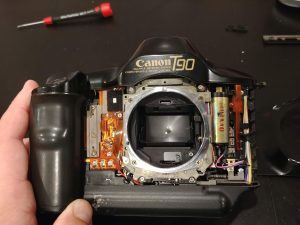
I found several “hacks” online for repairing the T90 in which you could use a strong magnet and place it next to some solenoid inside of the camera to demagnetize some part of the camera that would magically fix it. This required removal of a small piece of plastic trim around the front of the camera. It was easy enough to do, so I figured what do I have to lose?
I’ll just skip to the part where I tell you the “magnet hack” didn’t work. I used everything from simple refrigerator magnets to rare earth neodymium magnets from disassembled hard drives and I still kept getting the HELP message.
Then I found one more suggestion, which was to simply bang the camera on a hard surface until it started working. I thought “what the hell” and gave it shot! To my surprise, after a few very firm whacks on my basement floor, the camera started working! I could fire the shutter at every speed!
I fixed it! I was super pumped that I could finally shoot this wonderful T90, but it was close to midnight when I got it working, so I set it on the table to take it out the next day…
…and it was broke again. It would seem the ‘banging it on the floor’ method only works temporarily. I repeated my “repair” about half a dozen more times, repeatedly hitting it harder and harder, each time getting the shutter to work for maybe 5-10 minutes, but any longer than that and it returned to it’s previous EEE state.
I shelved this first Canon T90 and ended up finding another shortly after, but that one too, was broke. Oddly, it neither displayed the EEE or HELP messages, but rather just would never fire the shutter no matter what I did to it. With a sense of defeat, I threw the two T90s into a box and placed them in my “Camera Graveyard of Doom”, aka, my basement for it’s inclusion here in the 6th incantation of Cameras of the Dead.
If this had been a working camera, I’d have a complete historical look at the camera, it’s success, how it’s used and some sample pics I got from it, but that’ll never happen, and frankly, with the reputation the camera has, even if I had an opportunity to pick up another, I likely wouldn’t so here is a quick gallery of what the camera looks like and how it might have worked.
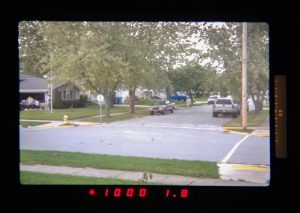
I’ll start with the viewfinder as it’s one of my favorite parts of the camera. Using a red 7-segment LED display straight out of Canon’s earlier A-1, the display within the viewfinder reminds me of one of those hand held Mattel football games that I had as a kid. Although it looks cool, it likely seemed dated compared to back lit LCD displays that were becoming more and more common with SLRs by the mid 1980s.
Curiously, along the right side of the display is a back lit LCD display that is used as the exposure metering display. Although the T90 offers full program auto exposure, you can manually set aperture, shutter speed, or both while still taking a light reading using this display. The display itself works fine, but it is a completely different color and looks strangely out of place compared to the bright red LED display along the bottom.
The top plate is uncluttered with two mode buttons that work in conjunction with a selector wheel on the camera’s right side between the LCD and shutter release. This being a camera aimed at the professional photographer, there is no integrated flash, rather you have a hot shoe with the necessary connections that when connected to a Canon Speedlite 300TL, offers all the latest TTL flash metering modes. When powered on, the LCD shows all pertinent information you would expect to see from a pro SLR’s top screen. The back of the camera has even more buttons, both above and below the film back. The back is removable so that you can attach a couple different data backs that were available. The film compartment is very modern and shows connections for DX detection, and is fully automatic. When loading in a new film cassette, extend the leader out to the orange mark, close the door, and the camera does the rest.
If you didn’t know better, judging by the T90s very 1986-esque design with lots of plastic and rounded corners, you would be forgiven for assuming this was an auto focus camera that uses Canon’s later EOS mount, but no, it was Canon’s venerable FD mount’s last hurrah, a fully manual focus camera that accepted every single FL/FD mount lens that came before it. When I acquired this T90, it came body only, so I mounted this 50mm f/1.4 S.S.C. lens which was a type that likely would have been used on it.
The side of the camera reveals a door which when held open, reveals several of the camera’s lesser used buttons, such as those for manually rewinding the film, battery check, self timer, and a viewfinder illumination switch. Keeping these lesser used buttons out of the way behind a door was a smart choice in keeping the top plate as uncluttered as possible.
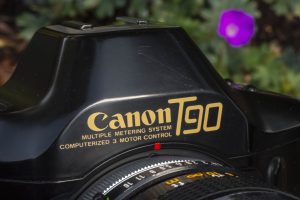
I think it’s rather curious that Canon named this camera the T90, including it in their T-series of cameras with the T50 and T70 (I am excluding the T60 as it wasn’t available upon the T90’s release and it wasn’t even made by Canon), this camera looks nothing like those other models, and is significantly more advanced. I have to imagine a customer walking into a camera store in 1986 likely would have been confused upon seeing all three T-series models side by side by side as the T90 was clearly in a different league, both feature wise and price wise from the other two.
It’s obvious to me that at one time the T90 was a fantastic camera, and in good working condition, would still be today. It’s a very solidly built camera with excellent ergonomics, a great shutter and metering system, uses every FD/FL mount lens available, and has nearly every feature you could possibly want in an SLR camera.
Sadly, the Canon T90 has the unfortunate distinction of being released at a time when a lot of new and innovative technology was being put into cameras for the first time, but that same technology was never intended to stay working 3+ decades later. Is it reasonable to expect any electronic camera to work for such a long time? Probably not, but when you can regularly pick up a 60 year old Nikon F or an 80 year old Leica and it still works fine, but something built within my lifetime is no longer usable, it’s a little disappointing.
The Canon T90 was a triumph of technology when it was first released, and people back then had a right to be excited. When the camera was first released, the photographic press was quick to publish detailed reviews of the camera. Here are two in depth looks at the Canon T90, both from the February 1986 issues of Popular and Modern Photography.
Related Posts You Might Enjoy
External Links
http://camera-wiki.org/wiki/Canon_T90
https://global.canon/en/c-museum/product/film118.html
http://www.canonclassics.com/canon-t90/20-18/
https://cameraquest.com/t90.htm
http://www.mir.com.my/rb/photography/hardwares/classics/canont90/index.htm
https://www.massmadesoul.com/canont90
https://lewiscollard.com/cameras/canon-t90/
https://flynngraphics.ca/the-collection/the-cameras/t-series/t-90/

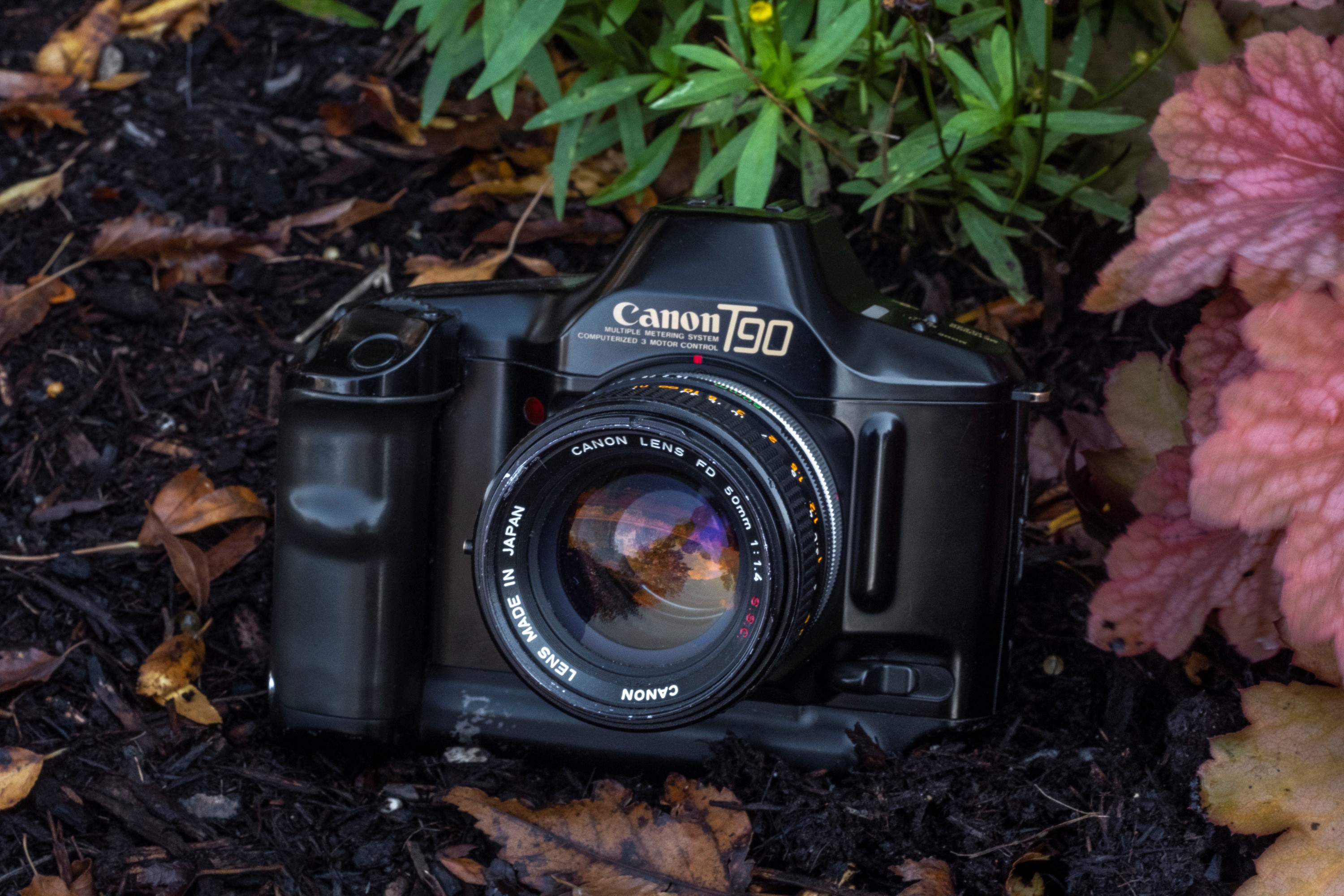
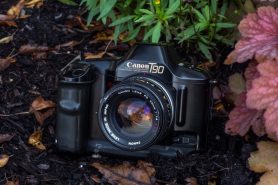
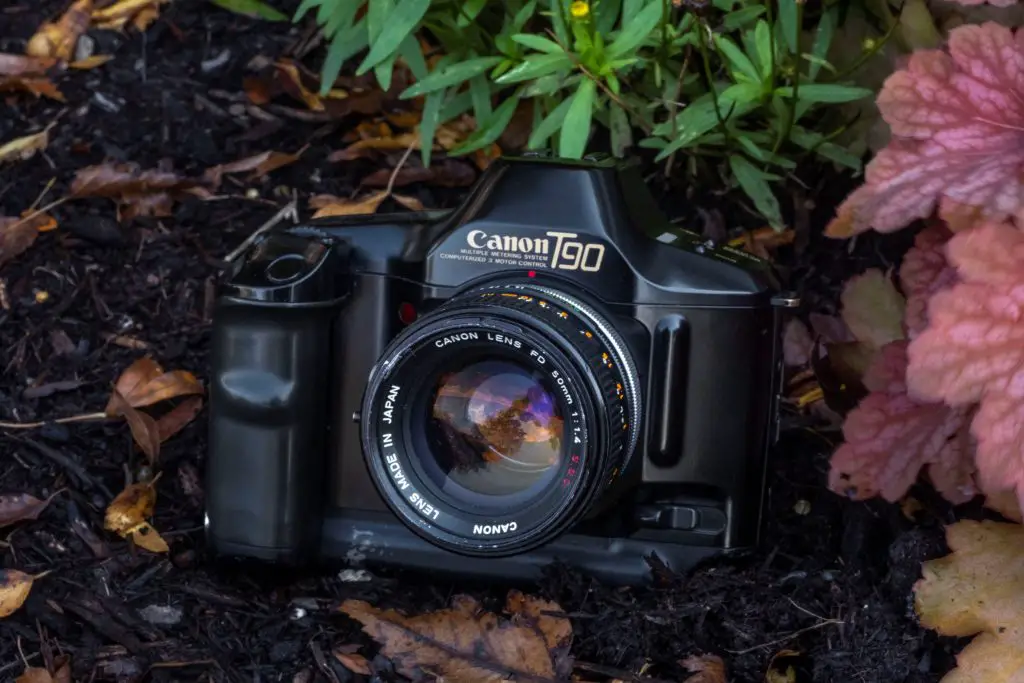
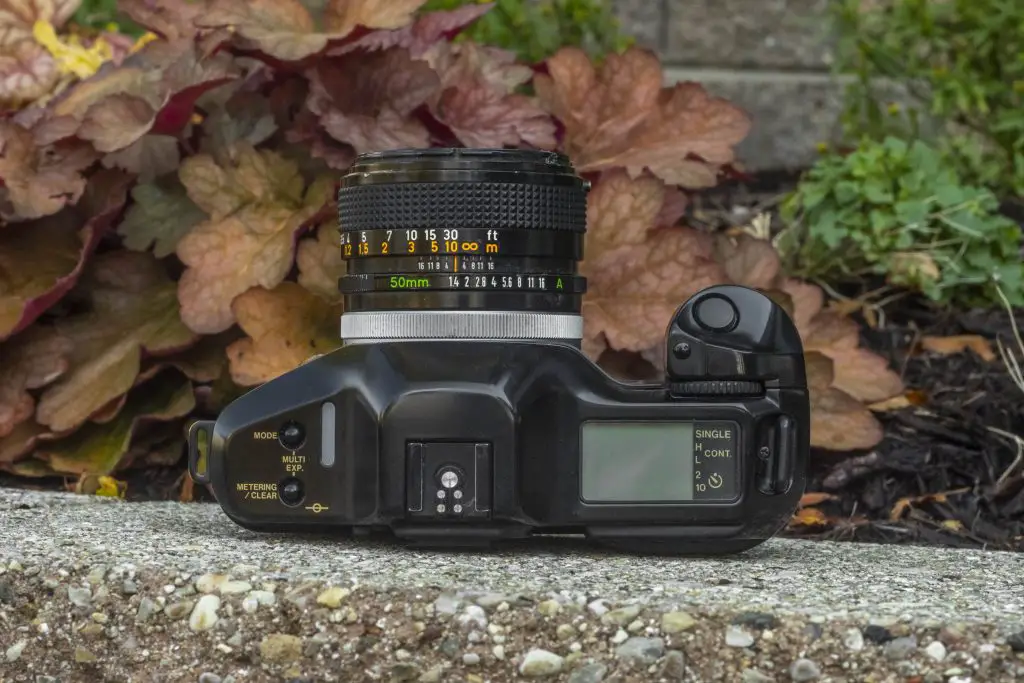
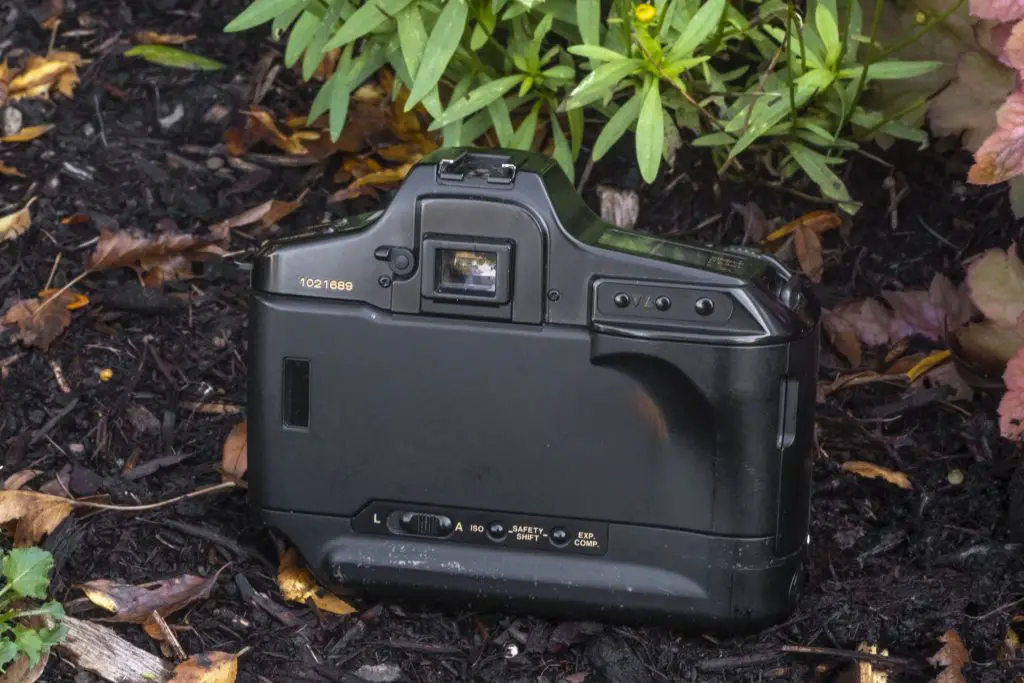
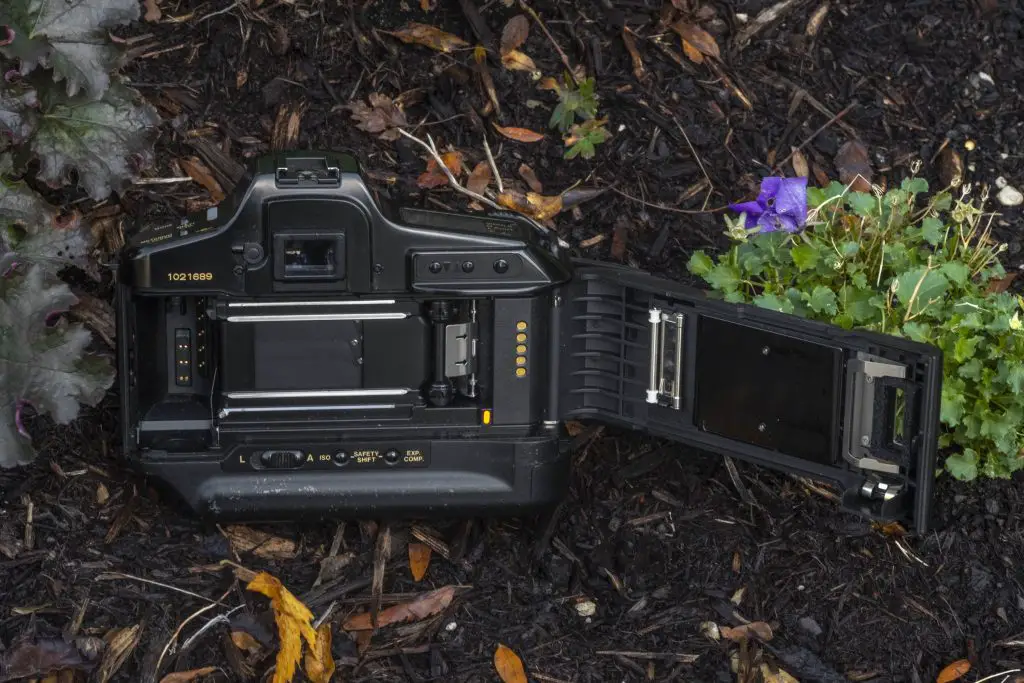
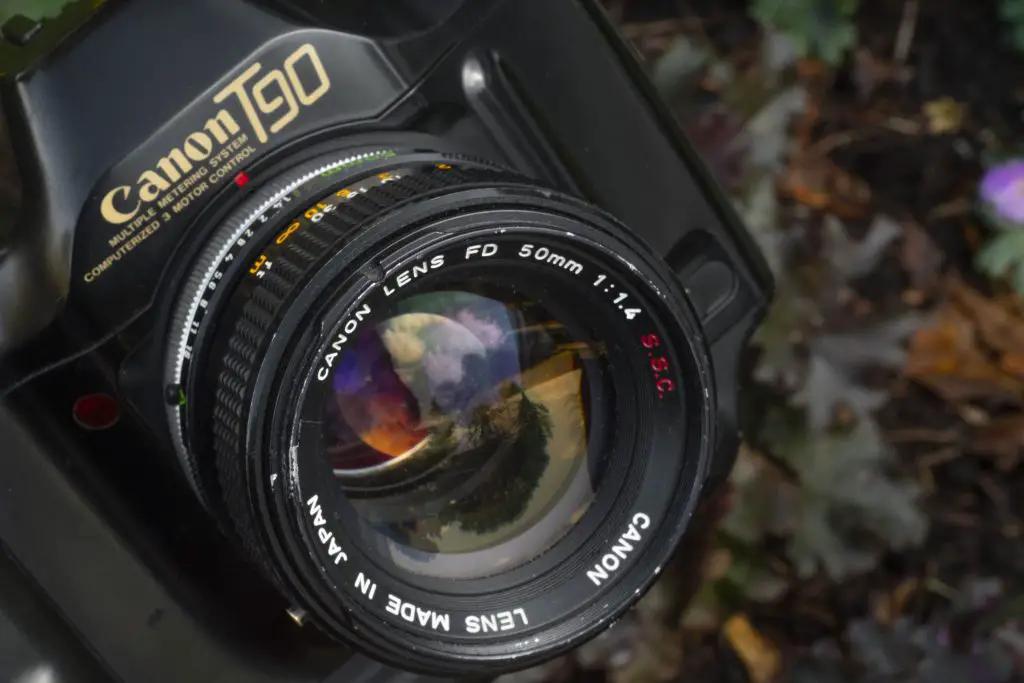
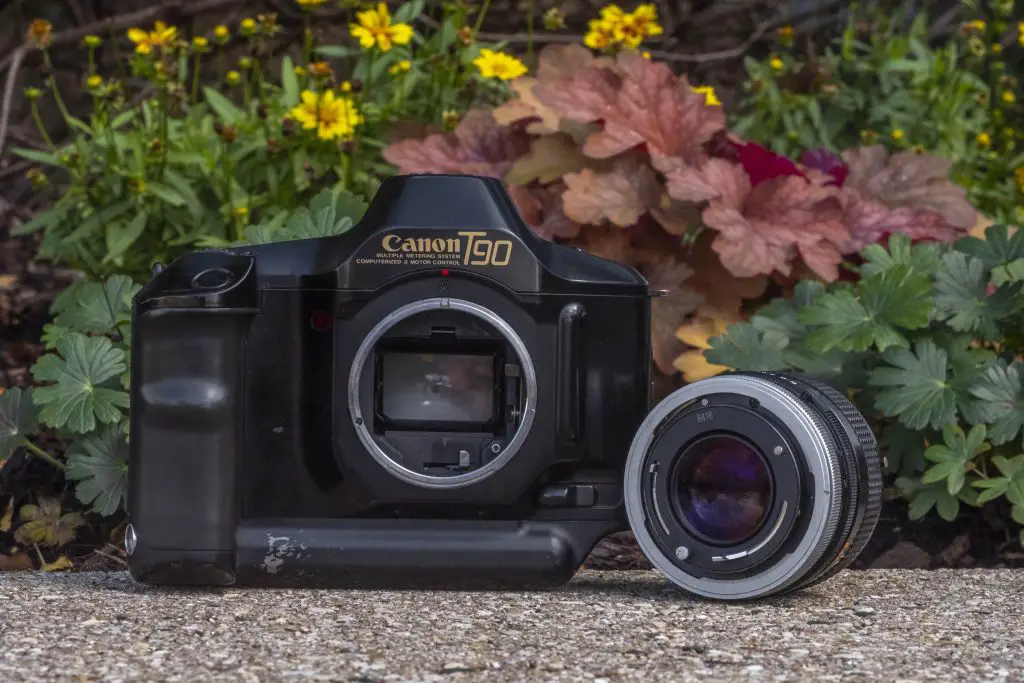
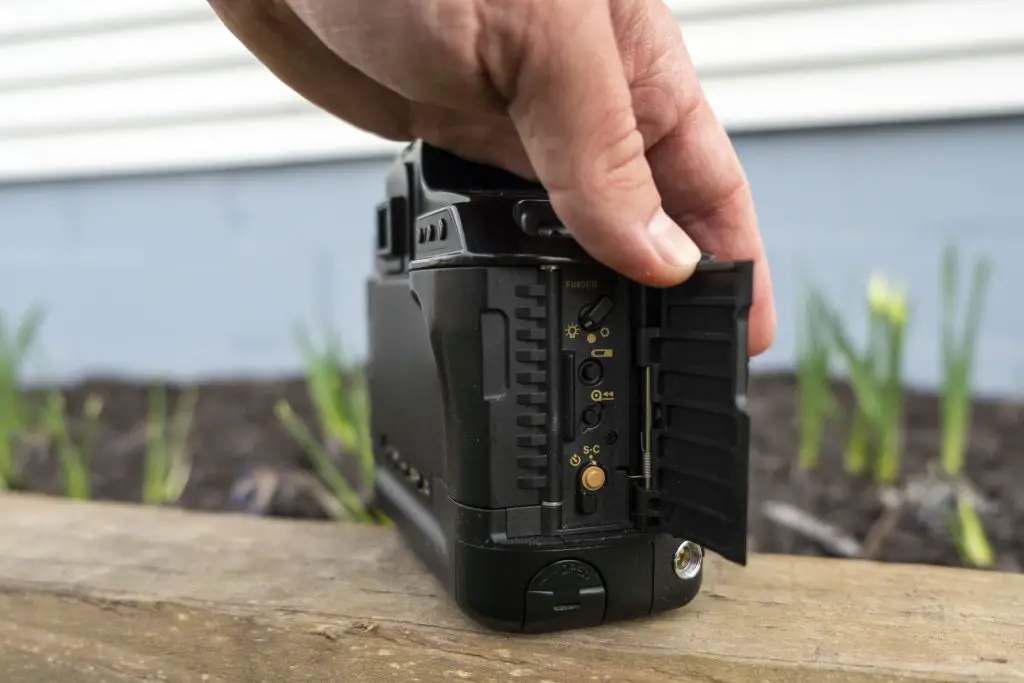
Darn Mike! I picked up a T80 based on a previous post — now I have to start looking for a T90! 🙂
Be careful, the EEE/HELP problem is very common and there’s very few people who will work on these due to the complexity of the electronics! It’s a fascinating camera for sure, but a higher risk than the T80.
Well — at my current works/does-not-work ratio (about 50/50), it would not be out of place to have a T90 sitting on the shelf never to be used! It has that “morphing into EOS” look to it, far less boxy than the T50-ish cameras…. You’re talking to a man here who has a bunch of Kodak Bull’s Eye cameras because they were made in different color schemes and I wanted a full set! 🙂 (and BTW — they do work fine!)
Mike you seem to have the worst luck. I bought a T90 two years ago in perfect working condition. It is the only manual focus Canon that I enjoy using. Keep looking.
My understanding of the failure is due to the electro-mechanical release of the shutter. From what I’ve heard, if the camera is regularly used, it will stay working. But many of these have sat idle for decades and when you try to get them working again, the magnet, or something within it, fails.
Hi, Mike. Contact Steve Swearingen at the Camera Clinic in Mandan, ND. I think he can fix your T90s.
Just a note from a casual collector: The Canon T90 was designed by the renowned German designer Luigi Colani.
Check out some of his other far out but unrealized camera designs for Canon
Thanks for the additional info. I guess Canon didn’t want to be left out of the “designer” sweepstakes as the Nikon F3 was also designed by someone famous.
I have a T90. It’s been carefully boxed in my basement since the last time I used it, sometime around 2001, so I guess I won’t be surprised if it no longer works.
I used it some, back then, and wasn’t in love with it.
What I remember most about it is the thunderous shutter/ film transport noise and vibration. With the camera in my right hand and the lens in my left, the whole assembly sort of twisted when the film advanced. I’m pretty sure this was from the motorized film transport process because the pictures were fine.
Polar opposite of the near-silent vibrationless Leica rangefinders I also used at the time.
Anyway, it was never a favorite.
The F-1n, on the other hand, was a gem.
Sadly, all of the cameras from the Canon T90 were loud like that. I have both a T50 and T80 and firing the shutter sounds like the sound sample that movie and TV sound effects editors used for the sound of all cameras for the past 30 years!
If you’re a fan of Canon manual focus cameras and like the F-1, I would also recommend trying out the Canon EF. I have a review of it on my site if you want to check it out, but it is my all time favorite Canon SLR!
I worked in a camera store in the 70s. They were heavily invested in Canon, and we (the “sales associates”) got, I think, a $5 spiff for selling an FTb.
We got to use all the brands, and the FTb was competent, but not much fun to use.
We would sell an FTb if the customer insisted, but our secret favorite at the time was the screw mount Fuji ST701. Smaller, quieter, at least as sharp, nicer overall. We suggested them to customers who we actually liked. We couldn’t have known at the time that the Fuji line was a dead end.
Sadly, Fuji continued to bet on the wrong lens mount and eventually withdrew from the market.
I don’t know if you’ve ever written about the ST701. If not, you should try it. I still have one, and use it a lot.
Scott, I don’t have the ST701, but do have the 901, and will have a review of it sometime next year!
The T90 seems to be in the same class as the Kowa SET-R: One has overly complex electronics, the other overly complex mechanicals.
I definitely see where you’re going as they’re both complex cameras, but to be perfectly honest, I think the odds of getting a working Kowa are better than the T90. At least people can still repair mechanical cameras. Once electronics truly die, they’re dead for good.
My brother had a T90 in 1989 and I recall being very impressed with it.At the I was using a Leica R3 and the T90 outshone it in every respect. More recently, as prices have dropped I’ve been tempted but reading of initial reports into their reliability any such thoughts have been put on the back burner. Now, reading your article, the T90 is off my radar and you’ve probably saved me a lot of anguish.
I’ve had better luck with my Ricoh GR1 which hasn’t been used since around 2002 but is still functioning fully. But this is another camera that is known to have in-built electronic failure credentials!
Good review. I’ve had a T-90 for years, works great, but been wracking my brain trying to figure out what that white bar next to the mode button does … Canon terms the ‘illumination window.’ Any thoughts?
As far as I know, it lets the light in for the Information bar (light metering) on the right in the Viewfinder. You can test this by putting your finger on it on and off and looking through the viewfinder. You can additionally backlight this per LED at night. I have a Canon T90 since 2009. The worry about the EEE always is in the back of your mind as you pick it up after a longer period of not using it. I normally fire it a couple of times every 2 to 3 months. I had the EEE ones on a nice night shooting diafilm from a snow landscape back in 2010. The camera was put upon an a tripod and it was very cold that night with minus degrees. The T90 and/or the batteries obviously did not like this. It scared the hell out of me but lucky for me, after it was back inside and warmed up it has not failed me since. Together with my Canon T70 and a Nikon L35AF I just love to use them regularly and still shoot film next to digital with my Canon 60D and the IPhone. The hardest part is to decide which cameras and lenses to take on holidays or day trips 🙂
Hey Mike, cool website 🙂
I started a hobby with film cameras this year, I was looking to buy the same camera of my father’s, a Canon AE-1, when I stumbled on a T-90 for sale on facebook market.
And it was in neat condition. I did show the EEE error while I was shooting my first film, though I saw somewhere on internet that it could eventually get back to work when you hold the shooting with the Continuous setting to high.
At first it was slow and erroring again, but with some patience and repeating it over and over, mine got back to work!!
It’s such an amazing camera, hope one day you get one in good shape on your hands.
Thanks for the compliment. As you know, the T90 is a cool camera, but I am 0 for 2 in getting ones to work and stay working. One of the two would eventually start working using a combination of whacking it on a hard surface and the continuous firing method you describe, but it would always return to EEE mode. I was never able to keep it working long enough to be able to shoot a roll of film through it. Hearing how common this problem is from many other collectors and users, you definitely got lucky that yours is still working. Unless one falls in my lap though, there’s far too many other, equally good cameras from that era, for me to purposely look for another though.
Yeah, I’m feeling even luckier reading your statement
I love the camera and I try to use it regularly as it likes to be 😀
But, it’s a monster to tame!!
cheers
The 20 year problem most T90s face is not the shutter solenoid, it’s the PRAM battery – the SETTINGS battery that dies if the main AAs are not kept in the camera. Before banging the snot out of the camera I’d make sure a new strong battery is installed.That requires a few tools and some soldering skills.
EEE HELP”: I succeeded fixing this shutter fault with a method l didn’t find elsewhere. I removed the film back and lens/ body cap for better access. Then, with the camera face-down dripped naptha lighter fluid on the shutter until fully wet. I fired the shutter several times until it faulted again. The shutter fires freely while soaked then faults when the exposed blades dry. I used the battery checker to clear the fault. I repeated this wash maybe 6 times then let it dry for a whole day. Now the shutter looks clean and operates normally. This seems like a better way than the smack.
I’m late to the Canon game. I just got one for Christmas 2021 with the shutter fault.The T90 has amazing features. Nikon has no equivalent camera in this class. The N2000 and N6000 are sad. I love this camera, thanks for the great article.
I left mine with half a roll of film 20 years ago. I just developed the film and started using it again. No problems!
I actually have had a T90 since about the late 2000’s and it is still in good working order! I occasionally shoot it. It’s one of my favorite FD mount cameras, probably my favorite actually. Only film camera I like better is my Canon Elan 7e. I also have a T50, and T70 (this was the family camera of my childhood) and all are still working. Sometimes the Motor on the T70 sounds like it’s slowing down, but every time if I put brand new AA’s in it, it perks back to life! SO I think it’s just battery drain. I’d love to get a T80 one day, and it’s 3 auto focus lenses to add to my collection.
Been listening to the Camerosity Podcast for the last several weeks fro the beginning, and loving it!